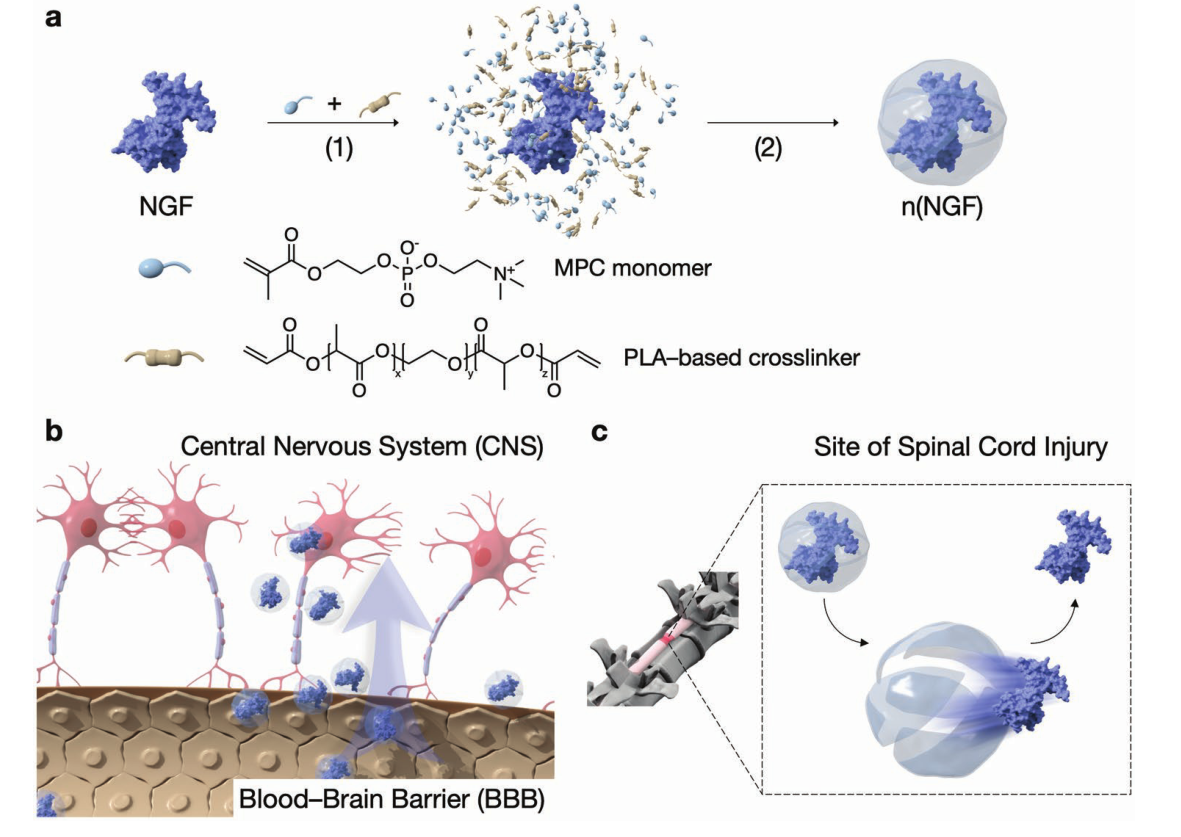
Adv. Mater. 2019, 31, 1900727
中枢神经系统(CNS)在控制感觉和运动功能方面起着核心作用,其屏障的破坏会导致严重的和衰弱的神经疾病。神经营养因子是一种很有前途的中枢神经系统损伤后神经再生的治疗剂。然而,它们对血脑屏障的穿透仍然是一个巨大的挑战,是脑和脊髓治疗的瓶颈。本文报道了一种能够通过静脉给药将NGF高效地输送到中枢神经系统的输送技术。该给药系统能有效延长血液循环半衰期而不引起全身反应,在损伤部位可持续释放NGF促进功能恢复,而不会引起促炎反应。这项技术可以用来传递广泛的修复前基序,如生长因子和免疫调节细胞因子,以促进损伤后的组织修复。神经营养因子通过这种基于纳米囊的系统高效、安全地进入中枢神经系统,可能为中枢神经系统损伤和神经退行性疾病的治疗开辟新的方向。
近日,加州大学洛杉矶分校化学与生物分子工程系及加州大学洛杉矶分校艾滋病研究所微生物学、免疫学和分子遗传学系教授报道了报道了一种基于纳米胶囊的给药系统,它能使静脉注射的神经生长因子(NGF)进入健康小鼠和非人灵长类动物的中枢神经系统。在病理条件下,神经生长因子可以促进脊髓损伤小鼠的神经再生、组织重塑和功能恢复。这项技术可以将其他神经营养因子和生长因子输送到中枢神经系统,为组织工程和治疗中枢神经系统疾病和神经退行性疾病开辟了一条新的途径。
The central nervous system (CNS) plays a central role in the control of sensory and motor functions, and the disruption of its barriers can result in severe and debilitating neurological disorders. Neurotrophins are promising therapeutic agents for neural regeneration in the damaged CNS. However, their penetration across the blood–brain barrier remains a formidable challenge, representing a bottleneck for brain and spinal cord therapy.we have developed a delivery technology that enables the efficient delivery of NGF into the CNS via intravenous administration. This delivery system can efficiently extend the blood circulation half-life without inducing a systemic response, and release NGF sustainably at the injured site to promote the functional recovery, without inducing the proin-flammatory reactions. This technology can be used to deliver a wide range of prorepair motifs such as growth factors and immunomodulating cytokines, to promote tissue repair after injury. The efficient and safe entry of neurotrophins to the CNS via this nanocapsule-based system may open future directions for the treatments of CNS injuries and neurodegenerative diseases.
Recently, Professor of Department of Chemical and Biomolecular Engineering University of California, Los Angeles and Department of Microbiology, Immunology, and Molecular Genetics
UCLA AIDS InstituteUniversity of California, Los Angeles reported a nanocapsule-based delivery system that enables intravenously injected nerve growth factor (NGF) to enter the CNS in healthy mice and nonhuman primates. Under pathological conditions, the delivery of NGF enables neural regeneration, tissue remodeling, and functional recovery in mice with spinal cord injury. This technology can be utilized to deliver other neurotro-phins and growth factors to the CNS, opening a new avenue for tissue engi-neering and the treatment of CNS disorders and neurodegenerative diseases.
DOI:10.1002/adma.201900727
刘天一